Urban Air Mobility Aircraft Operations in Urban Environments: A Review of Potential Safety Risks
Abstract
1. Introduction
2. Methodology
- UAM background and development: exploring the history and evolution of UAM systems and aircraft.
- Operational risks of UAM aircraft: identifying potential hazards and safety challenges during UAM operations, including piloted and autonomous systems.
- Risks posed by foreign object impact: focusing on the risks of UAM aircraft colliding with foreign objects, such as birds, drones, and debris, within dense urban environments.
- Current standards and regulations: reviewing existing aviation standards and regulations relevant to UAM issued by selected aviation authorities, including the Federal Aviation Administration (FAA), the European Union Aviation Safety Agency (EASA), and the Australian Civil Aviation Safety Authority (CASA).
- Statistical data on collisions of aircraft with foreign objects: gathering data and statistics related to collisions with foreign objects, including birds and drones, to assess the risk severity and frequency of these occurrences.
- Potential UAM configurations: analysing the different UAM aircraft configurations proposed by different manufacturers and their suitability for urban operations.
- Impact studies on rotor blade systems: reviewing studies that examine the damage caused by foreign object impact, specifically on rotor blades, and the implications for aircraft safety.
3. Findings from the Literature Review
3.1. Operational Risks Associated with UAM
3.2. Risks Posed by Impact with Foreign Objects
3.3. Currrent Standards and Regulations Related to Impact Events on Aircraft
3.4. Statistics on Aircraft Collision with Foreign Objects
3.4.1. Historical Data of Bird-Strike Events on Conventional Aircraft
3.4.2. Historical Data of Bird-Strike Events to Related Aircraft Types
3.4.3. Challenges Posed by UAM Operations in Urban Environments Specific to Bird Strikes
3.4.4. Lessons Learnt from the Operation of Drones in Urban Settings
3.4.5. Safety Considerations Related to Different UAM Rotor System Configurations
3.5. Overview of UAM Rotor Systems Configurations
3.6. Previous Birdstrike Studies on Rotorcraft
3.7. Previous Drone Collision Studies on Rotor Systems of Conventional Aircraft
4. Survey Results and Discussion
4.1. Survey Results—Key Findings
4.2. Risk Evaluation Based on the Survey Results
- Risks in the operation of UAM aircraft: Question (1) + Question (2)
- Risks of collision to the UAM aircraft: Question (3) + Question (4)
- Risks of impact associated with different UAM components: Question (5)
5. Conclusions
Funding
Data Availability Statement
Conflicts of Interest
Abbreviations
| AAM | Advanced Air Mobility |
| AGL | Above Ground Level |
| ASN | Aviation Safety Network |
| ATSB | Australian Transport Safety Bureau |
| CASA | Australian Civil Aviation Safety Authority |
| CHEAN | College Human Ethics Advisory Network |
| CS | Certification Specification |
| DEP | Distributed Electric Propulsion |
| EAR | Easy Access Rules |
| EASA | European Union Aviation Safety Agency |
| eVTOL | Electrical Vertical Take-Off and Landing |
| FAA | Federal Aviation Administration |
| FBW | Fly-By-Wire |
| FEM | Finite Element Method |
| FHA | Failure Hazard Analysis |
| FMECA | Failure Modes and Effects Criticality Analysis |
| FOD | Foreign Object Debris |
| FY | Financial Year |
| GA | General Aviation |
| HTOL | Horizontal Take-Off and Landing |
| ICAO | International Civil Aviation Organization |
| IPP | Integration Pilot Programme |
| ITS | Intelligent Transportation Systems |
| LTUs | Lift/Thrust Unit |
| NASA | National Aeronautics and Space Administration |
| RPT | Regular Public Transport |
| SPH | Smoothed Particle Hydrodynamic |
| TCAS | Traffic Collision Avoidance Systems |
| UA | Unmanned Aircraft |
| UAM | Urban Air Mobility |
| UAS | Unmanned Aircraft System |
| UAVs | Unmanned Aerial Vehicles |
| URSA | Unmanned Robotic Systems Analysis |
| UTM | Unmanned Traffic Management |
| VTOL | Vertical Take-Off and Landing |
References
- Federal Aviation Administration (FAA). Urban Air Mobility (UAM) Concept of Operations Version 2.0; Federal Aviation Administration (FAA): Washington, DC, USA, 2023. [Google Scholar]
- Civil Aviation Safety Authority (CASA). The RPAS and AAM Strategic Regulatory Roadmap; Civil Aviation Safety Authority (CASA): Canberra, Australia, 2022. [Google Scholar]
- Cohen, A.P.; Shaheen, S.A.; Farrar, E.M. Urban Air Mobility: History, Ecosystem, Market Potential, and Challenges. IEEE Trans. Intell. Transp. Syst. 2021, 22, 6074–6087. [Google Scholar] [CrossRef]
- International Forum for Aviation research (IFAR). Scientific Assessment for Urban Air Mobility (UAM); International Forum for Aviation research (IFAR): Montreal, QC, Canada, 2023. [Google Scholar]
- Straubinger, A.; Rothfeld, R.; Shamiyeh, M.; Büchter, K.-D.; Kaiser, J.; Plötner, K.O. An overview of current research and developments in urban air mobility–Setting the scene for UAM introduction. J. Air Transp. Manag. 2020, 87, 101852. [Google Scholar]
- Aeromobil. Be the Experience. 2022. Available online: https://www.aeromobil.com/#experience (accessed on 17 March 2025).
- BLADE. BLADE Operating Standards and Flight Safety FAQs. Available online: https://www.blade.com/p/safety (accessed on 25 September 2024).
- Cao, S. Uber Tosses Flying Cars and Self-Driving to Focus on Core Business. Observer. 2020. Available online: https://observer.com/2020/12/uber-sell-self-driving-flying-car-focus-on-ride-sharing-food-delivery/ (accessed on 25 September 2024).
- Voom. Transformed the Urban Commute by Making Helicopter Taxis Affordable and accessible. An On-Demand Helicopter Book Platform. Acubed, Airbus. Available online: https://acubed.airbus.com/projects/voom/ (accessed on 25 September 2024).
- Australian Government. Eve Air Mobility (Eve) Welcomes the Release of the Australian Government’s Terms of Reference; The Department of Infrastructure, Transport, Regional Development, Communications and the Arts: Canberra, Australia, 2023. [Google Scholar]
- Reuters. Wisk Aero Partners with Airservices Australia as it Readies Air Taxi Launch. 16 October 2024 ed. 2024. Available online: https://www.reuters.com/business/aerospace-defense/wisk-aero-partners-with-airservices-australia-it-readies-air-taxi-launch-2024-10-15/?utm_source=chatgpt.com (accessed on 18 January 2025).
- Skyportz. Delivering the Infrastructure of the Future. 2024. Available online: https://skyportz.com/ (accessed on 18 January 2025).
- McNabb, M. Swoop Aero Medical Drone Delivery in Australia: Eliminating a 3 hour Drive to the Pharmacy. 22 February 2021 ed.; Drone Life. 2021. Available online: https://dronelife.com/2021/02/22/swoop-aero-medical-drone-delivery-in-australia-eliminating-a-3-hour-drive-to-the-pharmacy/ (accessed on 18 January 2025).
- Civil Aviation Safety Authority (CASA). Drone Delivery Services. 2025. Available online: https://www.casa.gov.au/drones/industry-initiatives/drone-delivery-services#Approveddeliverylocations (accessed on 18 January 2025).
- Nagle, M. Wing Expands Service to Melbourne with DoorDash While Advancing Australian Regulatory Approvals–Drone Delivery Set to Launch at Brookfield Properties’ Dallas-Fort Worth Malls in Partnership with DoorDash. 17 July 2024 ed.; Wing. 2025. Available online: https://wing.com/news/wing-melbourne-doordash (accessed on 18 January 2025).
- Australian Government. Australian Zero-Emissions Aircraft Concept to Decarbonise Aviation. 29 October 2024 ed.; Department of Industry, Science, and Resources. 2024. Available online: https://www.industry.gov.au/news/australian-zero-emissions-aircraft-concept-decarbonise-aviation (accessed on 18 January 2025).
- Commercial UAV News. FlyFreely Joins Newly-Established Research Body to Advance Australia’s Aerospace Sector. 1 July 2024 ed. 2024. Available online: https://www.commercialuavnews.com/flyfreely-joins-newly-established-research-body-to-advance-australia-s-aerospace-sector?utm_source=chatgpt.com (accessed on 18 January 2025).
- Electric VTOL News. Joby Aviation S4 2.0 (Pre-Production Prototype). The Vertical Flight Society. 2024. Available online: https://evtol.news/joby-s4 (accessed on 18 January 2025).
- Riboura, T. The First Full-Scale Prototype of Eve’s eVTOL. 22 July 2024 ed.; Eve Air Mobility Australian Flying. Available online: https://www.australianflying.com.au/latest/eve-unveils-full-scale-evtol-prototype (accessed on 18 January 2025).
- Wisk Aero. Wisk to Provide and Operate up to 30 Electric Vertical Aircraft for Key Blade Urban Air Mobility Routes. 5 May 2021 ed. 2021. Available online: https://wisk.aero/news/press-release/blade-wisk/ (accessed on 18 January 2025).
- Wang, L.; Deng, X.; Gui, J.; Jiang, P.; Zeng, F.; Wan, S. A review of Urban Air Mobility-enabled Intelligent Transportation Systems: Mechanisms, applications and challenges. J. Syst. Archit. 2023, 141, 102902. [Google Scholar] [CrossRef]
- WIRED. Over Drive. WIRED 2000. Available online: https://www.wired.com/2000/01/flyingcar/ (accessed on 25 September 2024).
- Future Flight. The Future of Advanced Air Mobility: Cora. Available online: https://www.futureflight.aero/aircraft-program/cora (accessed on 25 November 2023).
- EHang. EHang 216F (Firefighting Model) Best Solution for Urban High-Rise Firefighting. Available online: https://www.ehang.com/ehang216f/ (accessed on 25 November 2023).
- Vivek, R.; Nanthagopan, Y. Review and Comparison of Multi-Method and Mixed Method Application in Research Studies. Eur. J. Manag. Issues 2021, 29, 200–208. [Google Scholar] [CrossRef]
- Leslie, J. Drone Survey Services 2022. Available online: https://dronesurveyservices.com/drone-statistics/#:~:text=Drone%20Incidents%20Statistics%3A,incidents%2C%20with%20125%20cases%20reported (accessed on 10 October 2023).
- Darmstadt, P.R.; Catanese, R.; Beiderman, A.; Dones, F.; Chen, E.; Mistry, M.P.; Babie, B.; Beckman, M.; Preator, R. Hazards Analysis and Failure Modes and Effects Criticality Analysis (Fmeca) of Four Concept Vehicle Propulsion Systems; National Aeronautics and Space Administration, Glenn Research Center: Cleveland, OH, USA, 2019; No. NASA/CR-2019-220217. [Google Scholar]
- Courtin, C.; Hansman, R.J. Safety considerations in emerging electric aircraft architectures. In Proceedings of the 2018 Aviation Technology, Integration, and Operations Conference, Atlanta, GA, USA, 25–29 June 2018; p. 4149. [Google Scholar]
- Federal Aviation Administration (FAA) Air Traffic Organization, S.O.S. Air Traffic by the Numbers; Federal Aviation Administration (FAA) Air Traffic Organization: Canberra, Australia, 2024. [Google Scholar]
- Bureau of Infrastructure and Transport Research Economics (BITRE). Domestic Aviation Activity 2023; Australian Government: Canberra, Australia, 2024. [Google Scholar]
- Bureau of Infrastructure and Transport Research Economics (BITRE). Domestic Aviation Activity-Summary. July 2024 ed.; Bureau of Infrastructure and Transport Research Economics (BITRE). 2024. Available online: https://www.bitre.gov.au/statistics/aviation/domestic#anc_summary (accessed on 10 September 2024).
- Bauranov, A.; Rakas, J. Urban air mobility and manned eVTOLs: Safety implications. In Proceedings of the 2019 IEEE/AIAA 38th Digital Avionics Systems Conference (DASC), San Diego, CA, USA, 8–12 September 2019; pp. 1–8. [Google Scholar] [CrossRef]
- Cokorilo, O. Urban Air Mobility: Safety Challenges. Transp. Res. Procedia 2020, 45, 21–29. [Google Scholar] [CrossRef]
- Mills, M.J.E. Foreign Object Damage: Causes and Prevention; US Army Safety Center: Washington, DC, USA, 1980. [Google Scholar]
- Advisory Circular. AC 150/5210-24: Airport Foreign Object Debris (FOD) Management; Federal Aviation Administration: Washington, DC, USA, 2010. [Google Scholar]
- Aldao, E.; González-de Santos, L.M.; González-Jorge, H. LiDAR based detect and avoid system for UAV navigation in UAM corridors. Drones 2022, 6, 185. [Google Scholar] [CrossRef]
- European Union Aviation Safety Agency (EASA). Urban Air Mobility (UAM)-EASA Regulatory Activities. 2024. Available online: https://www.easa.europa.eu/en/domains/drones-air-mobility/drones-air-mobility-landscape/urban-air-mobility-uam (accessed on 10 September 2024).
- Patterson, M.D.; Antcliff, K.R.; Kohlman, L.W. A proposed approach to studying urban air mobility missions including an initial exploration of mission requirements. In Proceedings of the Annual Forum and Technology Display, Phoenix, AZ, USA, 15–17 May 2018. [Google Scholar]
- Dolbeer, R.A.; Begier, M.J.; Miller, P.R.; Weller, J.R.; Anderson, A.L. Wildlife Strikes to Civil Aircraft in the United States, 1990–2023; Department of Transportation. Federal Aviation Administration: Washington, DC, USA, 2024. [Google Scholar]
- Cardoso, S.H.S.B.; Oliveira, M.V.R.d.; Godoy, J.R.S. eVTOL Certification in FAA and EASA Performance-Based Regulation Environments: A Bird Strike Study-Case. J. Aerosp. Technol. Manag. 2022, 14, e2122. [Google Scholar]
- Mou, Y.; Jiang, M.; Zhu, G. Certification Considerations of eVTOL Aircraft. In Proceedings of the 32nd Congress of International Council of the Aeronautical Sciences, Shanghai, China, 6–10 September 2021. [Google Scholar]
- European Union Aviation Safety Agency (EASA). Special Condition for Small-Category VTOL-Capable Aircraft; European Union Aviation Safety Agency (EASA): Cologne, Germany, 2024. [Google Scholar]
- European Union Aviation Safety Agency (EASA). Easy Access Rules for U-Space; European Union Aviation Safety Agency (EASA): Cologne, Germany, 2024. [Google Scholar]
- European Union Aviation Safety Agency (EASA). Acceptable Means of Compliance and Guidance Material to Regulation (EU); European Union Aviation Safety Agency (EASA): Cologne, Germany, 2022. [Google Scholar]
- Hobbins, P. Helicopter Crashes in City. State Library New South Wales: Dictionary of Sydney. 2018. Available online: https://dictionaryofsydney.org/blog/helicopter_crashes_in_city (accessed on 20 December 2023).
- Mangan, D.; Breauninger, K. One Dead After Helicopter Crash-Lands on Roof of Midtown Manhattan Building. CNBC. 2019. Available online: https://www.cnbc.com/2019/06/10/helicopter-crashes-into-building-in-midtown-manhattan.html (accessed on 20 December 2023).
- Lynch, B. Florida Helicopter Crash: Two Killed as Burning Chopper Smashes into Apartment Building. Mirror. 2023. Available online: https://www.mirror.co.uk/news/us-news/florida-helicopter-crash-chopper-smashes-30804744 (accessed on 20 December 2023).
- Australian Transport Safety Bureau. Australian Aviation Wildlife Strike Statistics 2008–2017; Australian Transport Safety Bureau: Canberra, Australia, 2019. [Google Scholar]
- Bureau, A.T.S. Australian Aviation Wildlife Strike Statistics 2006 to 2015; Australian Transport Safety Bureau: Canberra, Australia, 2017. [Google Scholar]
- Dolbeer, R.A. Population Increases of Large Bird Species in North America Pose Challenges for Aviation Safety. In Proceedings of the 2019 North American Bird Strike Conference, Halifax, Canada, 12–15 August 2019; pp. 12–15. [Google Scholar]
- Flight Safety Foundation. Business Aviation Global Accident Dashboard 2023. Aviation Safety Network (ASN). 2023. Available online: https://aviation-safety.net/dashboard/bizav (accessed on 10 September 2024).
- Civil Aviation Safety Authority (CASA). Robinson Helicopter Occurrence Analysis; Civil Aviation Safety Authority (CASA): Canberra, Australia, 2023. [Google Scholar]
- National Transportation Safety Board (NTSB). Aviation Investigation Preliminary Report; Flight Safety Foundation: Alexandria, VA, USA, 2024. [Google Scholar]
- National Transportation Safety Board (NTSB). Aviation Investigation Final Report; Flight Safety Foundation: Alexandria, VA, USA, 2024. [Google Scholar]
- Skakuj, H.M.; Chylarecki, P. Wildlife Hazard Management and Urban Air Mobility. 23 June 2022 ed.; World Birdstrike Association. 2022. Available online: https://www.worldbirdstrike.com/images/2022/WBA_British_Irish_Expo_22to23_June_2022/2022-06-19_BIAE_WBA_SKAKUJ_DE_HOON_02.pdf (accessed on 28 October 2023).
- Isaksson, C. Impact of Urbanization on Birds. In Bird Species: How They Arise, Modify and Vanish; Tietze, D.T., Ed.; Springer International Publishing: Cham, Switzerland, 2018; pp. 235–257. [Google Scholar] [CrossRef]
- European Union Aviation Safety Agency (EASA). Study on the Societal Acceptance of Urban Air Mobility in Europe; European Union Aviation Safety Agency (EASA): Cologne, Germany, 2021. [Google Scholar]
- Dilba, D. Integrating Unmanned Drones and Air Taxis into the Airspace. Aero Report, MTU Aero Engines. 2021. Available online: https://aeroreport.de/en/innovation/integrating-unmanned-drones-and-air-taxis-into-the-airspace (accessed on 28 October 2023).
- Australian Transport Safety Bureau. Mid-Air Collision Involving Robinson R22 Beta II, VH-HQH, and Robinson R22 Beta II, VH-HYQ; Australian Transport Safety Bureau (ATSB): Canberra, Australia, 25 July 2024. [Google Scholar]
- Gettinger, D.; Michel, A.H. Drone Sightings and Close Encounters: An Analysis; Center for the Study of the Drone, Bard College: Annandale-on-Hudson, NY, USA, 2015. [Google Scholar]
- Thorn, A. Explosion in ‘Near Encounters’ Between Aircraft and Drones. Australia Aviation. 2020. Available online: https://australianaviation.com.au/2020/04/explosion-in-near-encounters-between-aircraft-and-drones/ (accessed on 28 October 2023).
- Pinholster, G. Study Offers Objective Insights to Near-Miss Collisions Between Drones, Airplanes. 24 July 2023 ed.; Embry-riddle Aeronautical University: 2023. Available online: https://news.erau.edu/headlines/study-offers-objective-insights-to-near-miss-collisions-between-drones-airplanes (accessed on 17 November 2024).
- BCC News. Gatwick Flight Drone Near-Miss Put 130 Lives at Risk. 2017. Available online: https://www.bbc.com/news/uk-england-sussex-41627552 (accessed on 17 November 2024).
- Unmanned Airspace. EASA Publishes New Data on Serious Drone Accidents and Incidents for 2023 in the EU. 8 July 2024 ed.; Unmanned Airspace. 2024. Available online: https://www.unmannedairspace.info/uncategorized/easa-publishes-new-data-on-serious-drone-accidents-and-incidents-for-2023-in-the-eu/ (accessed on 17 November 2024).
- Austen, W.; Lord, S.J.; Bridges, S.A. Vulnerability of manned aircraft to drone strikes. sl: EASA. 2020. C04 Qinetiq; European Union Aviation Safety Agency, Cody Technology Park: Farnborough, UK, 29 January 2021; D2.1; QINETIQ/21/00076/1.0. [Google Scholar]
- Aviation Rulemaking Advisory Committee (ARAC). Rotorcraft Bird Strike WG Recommendations to ARAC; Aviation Rulemaking Advisory Committee (ARAC): Washington, DC, USA, 2019. [Google Scholar]
- Australian Transport Safety Bureau (ATSB). Birdstrike and In-Flight Break-Up Involving a Bell 206L-1, Registered VH-ZMF; Australian Transport Safety Bureau (ATSB): Canberra, Australia, 2023. [Google Scholar]
- Prakasha, P.S.; Ratei, P.; Naeem, N.; Nagel, B.; Bertram, O. System of systems simulation driven urban air mobility vehicle design. In Proceedings of the AIAA Aviation 2021 Forum, Virtual, 2–6 August 2021; p. 3200. [Google Scholar]
- Roshanian, J.; Darvishpoor, S.; Georgiev, K.; Serbezov, V. Vehicle Configurations, Infrastructures, and Future of Urban Air Mobility: A Review. AIP Conf. Proc. 2022, 2980, 050001. [Google Scholar]
- Voltaero. The Vision. 2025. Available online: https://www.voltaero.aero/the-vision/ (accessed on 17 March 2025).
- Ugwueze, O.; Statheros, T.; Horri, N.; Bromfield, M.A.; Simo, J. An Efficient and Robust Sizing Method for eVTOL Aircraft Configurations in Conceptual Design. Aerospace 2023, 10, 311. [Google Scholar] [CrossRef]
- Silva, C.; Johnson, W.; Solis, E.; Patterson, M.; Antcliff, K. VTOL Urban Air Mobility Concept Vehicles for Technology Development; ARC: Reston, VA, USA, 2018. [Google Scholar] [CrossRef]
- Marzouk, O. Urban air mobility and flying cars: Overview, examples, prospects, drawbacks, and solutions. Open Eng. 2022, 12, 662–679. [Google Scholar] [CrossRef]
- Huff, D.L.; Henderson, B.S.; Cluts, J.D.; Boyle, D.K.; Bennett, J.; Janzen, J. Noise Measurements from Ground Tests of the Moog SureFly Vehicle. In Proceedings of the AIAA Aviation 2021 Forum, Virtual, 2–6 August 2021; p. 2209. [Google Scholar]
- Scerri, A. Eve’s Johann Bordais on Developing a Lift-Plus-Cruise eVTOL Aircraft. 14 March 2024 ed.; Vertical. 2024. Available online: https://verticalmag.com/q-and-a/eves-johann-bordais-on-developing-a-lift-plus-cruise-evtol-aircraft/ (accessed on 17 March 2025).
- Warwick, G. Boeing, Kitty Hawk Unveil UAM Joint Venture. 2 December 2019 ed.; Aviation Week network. 2019. Available online: https://aviationweek.com/boeing-kitty-hawk-unveil-uam-joint-venture (accessed on 25 September 2024).
- Electic VTOL News. Archer Aviation Midnight (Production Aircraft). Vertical Flight Society. 2024. Available online: https://evtol.news/archer/ (accessed on 17 March 2025).
- Antcliff, K.; Whiteside, S.; Kohlman, L.W.; Silva, C. Baseline assumptions and future research areas for urban air mobility vehicles. In Proceedings of the AIAA SciTech 2019 Forum, San Diego, CA, USA, 7–11 January 2019; p. 0528. [Google Scholar]
- Whiteside, S.K.; Pollard, B.P. Conceptual design of a tiltduct reference vehicle for urban air mobility. In Proceedings of the Aeromechanics for Advanced Vertical Flight Technical Meeting, Transformative Vertical Flight, San Jose, CA, USA, 25–27 January 2022. [Google Scholar]
- Johnson, W.; Silva, C.J. Observations from Exploration of VTOL Urban Air Mobility Designs. AIP Conf. Proc. 2024, 2980, 050001. [Google Scholar]
- Olivares, G.; Kona Ravi, A.; Bhasin, A.; Roberson, M.; Huberty, W.; Bounds, C. Advanced Materials and Processes Survey for AAM and UAS Aircraft; National Institute for Aviation Research, Wichita State University: Wichita, KS, USA, 2022. [Google Scholar] [CrossRef]
- Raj, S. Influence of Materials Requirements on the Design of Transformational Vertical Flight Aerial Vehicles for Public Access. In Proceedings of the Telecom Meeting NASA Transformational Vertical Flight Working Group, Cleveland, OH, USA, 19 April 2018. [Google Scholar]
- Diab Aerospace. Core Materials for Urban Air Mobility. Diab Group. 2024. Available online: https://www.diabgroup.com/markets/aerospace/ (accessed on 25 September 2024).
- Aubry, J.; Navarro, P.; Tawk, I.; Marguet, S.; Ferrero, J.-F.; Lemaire, S.; Rauch, P. Experimental and numerical study of normal and oblique impacts on helicopter blades. Dyn. Fail. Compos. Sandw. Struct. 2013, 1, 545–575. [Google Scholar]
- Pascal, F.; Navarro, P.; Marguet, S.; Ferrero, J.-F. On the modelling of low to medium velocity impact onto woven composite materials with a 2D semi-continuous approach. Compos. Struct. 2015, 134, 302–310. [Google Scholar]
- Eren, Z.; Tataroglu, S.; Balkan, D.; Mecitoglu, Z. Modeling of bird strike on a composite helicopter rotor blade. In Proceedings of the 58th AIAA/ASCE/AHS/ASC Structures, Structural Dynamics, and Materials Conference, Grapevine, TX, USA, 9–13 January 2017; p. 1991. [Google Scholar]
- Husainie, S.N. Bird Strike and Novel Design of Fan Blades. In Proceedings of the 2017 Science in the Age of Experience, Chicago, IL, USA, 1 May 2017. [Google Scholar]
- Wu, B.; Hedayati, R.; Li, Z.; Aghajanpour, M.; Zhang, G.; Zhang, J.; Lin, J. Effect of impact and bearing parameters on bird strike with aero-engine fan blades. Appl. Sci. 2021, 12, 7. [Google Scholar] [CrossRef]
- Wilbeck, J.S. Impact Behavior of Low Strength Projectiles; Texas A&M University: College Station, TX, USA, 1977. [Google Scholar]
- Song, Y.; Horton, B.; Bayandor, J. Investigation of UAS ingestion into high-bypass engines, Part 1: Bird vs. drone. In Proceedings of 58th AIAA/ASCE/AHS/ASC Structures, Structural Dynamics, and Materials Conference, Grapevine, TX, USA, 9–13 January 2017; p. 0186. [Google Scholar]
- Schroeder, K.; Song, Y.; Horton, B.; Bayandor, J. Investigation of UAS ingestion into high-bypass engines, Part 2: Parametric drone study. In Proceedings of the 58th AIAA/ASCE/AHS/ASC Structures, Structural Dynamics, and Materials Conference, Grapevine, TX, USA, 9–13 January 2017; p. 0187. [Google Scholar]
- D’Souza, K.; Lyons, T.; Lacy, T.; Kota, K.R. Volume IV–UAS Airborne Collision Severity Evaluation–Engine Ingestion. U.S. Department of Transportation, Federal Aviation Administration: Washington, DC, USA, August 2017. [Google Scholar]
- Lyons, T.; D’Souza, K. Parametric study of a unmanned aerial vehicle ingestion into a business jet size fan assembly model. J. Eng. Gas Turbines Power 2019, 141, 071002. [Google Scholar]
- Liu, H.; Hasrizam Che Man, M.; Ng, B.F.; Low, K.H. Airborne collision severity study on engine ingestion caused by harmless-categorized drones. In Proceedings of the AIAA Scitech 2021 Forum, Virtual, 11–21 January 2021; p. 1263. [Google Scholar]
- CQE Academy. Risk Oversight. 2017. Available online: https://www.cqeacademy.com/wp-content/uploads/2017/01/Risk-Management.pdf (accessed on 25 September 2024).
- Civil Aviation Safety Authority (CASA). SMS 3 Safety Risk Management; Australian Government: Canberra, Australia, 2022; CC BY 4.0. Available online: https://www.casa.gov.au/sites/default/files/2021-06/safety-management-systems-book-3-safety-risk-management.pdf (accessed on 25 September 2024).

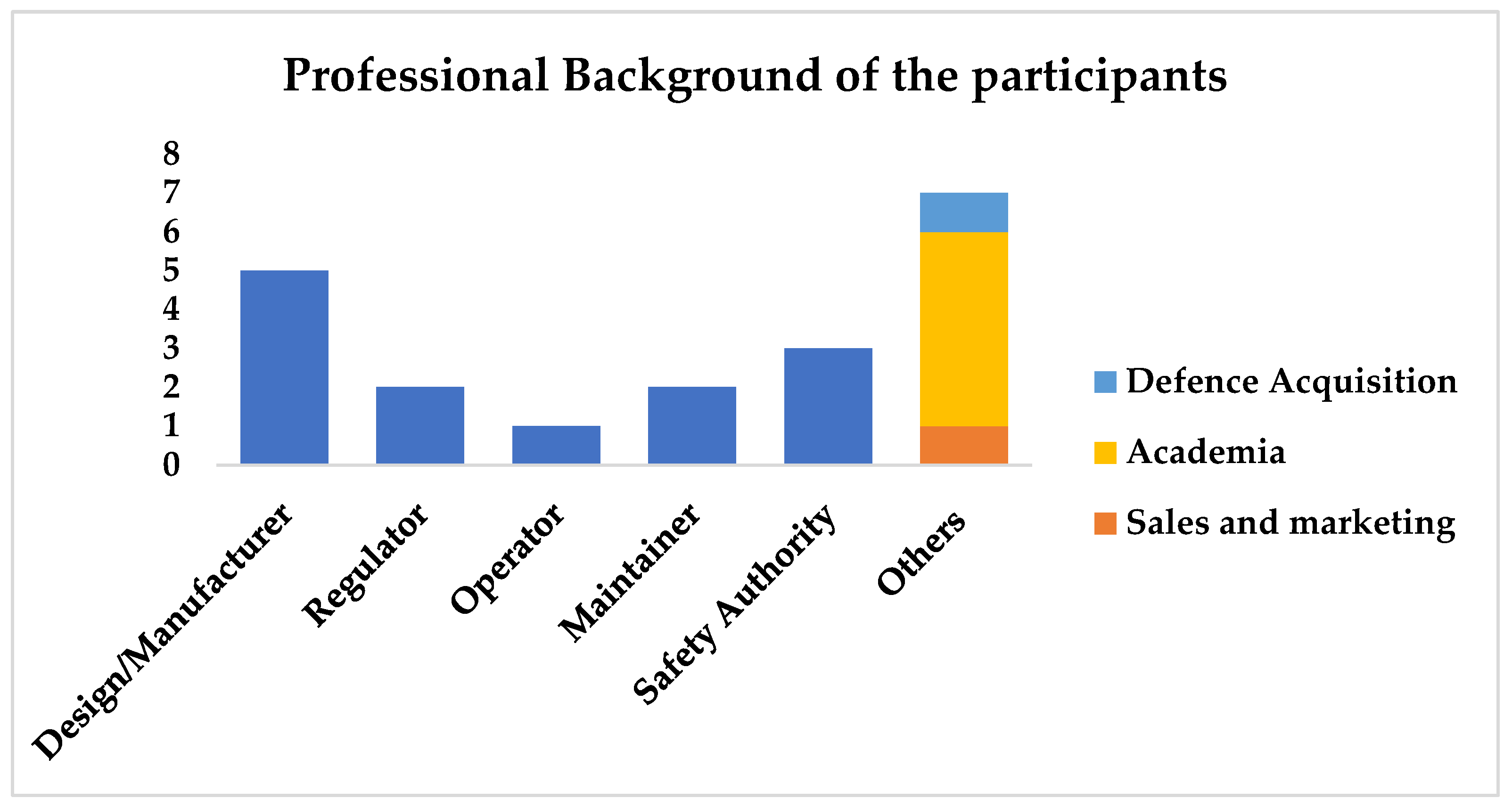
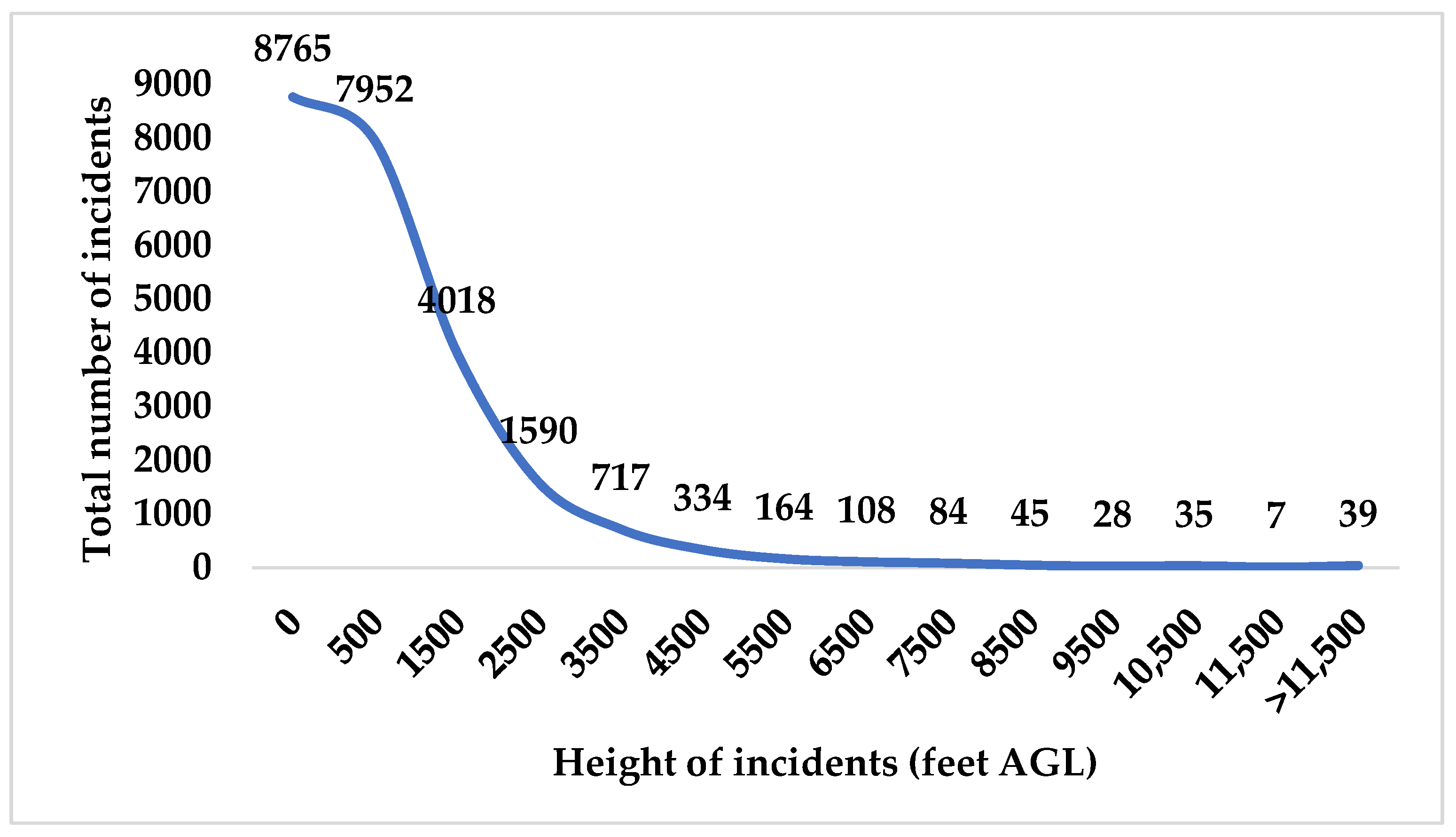
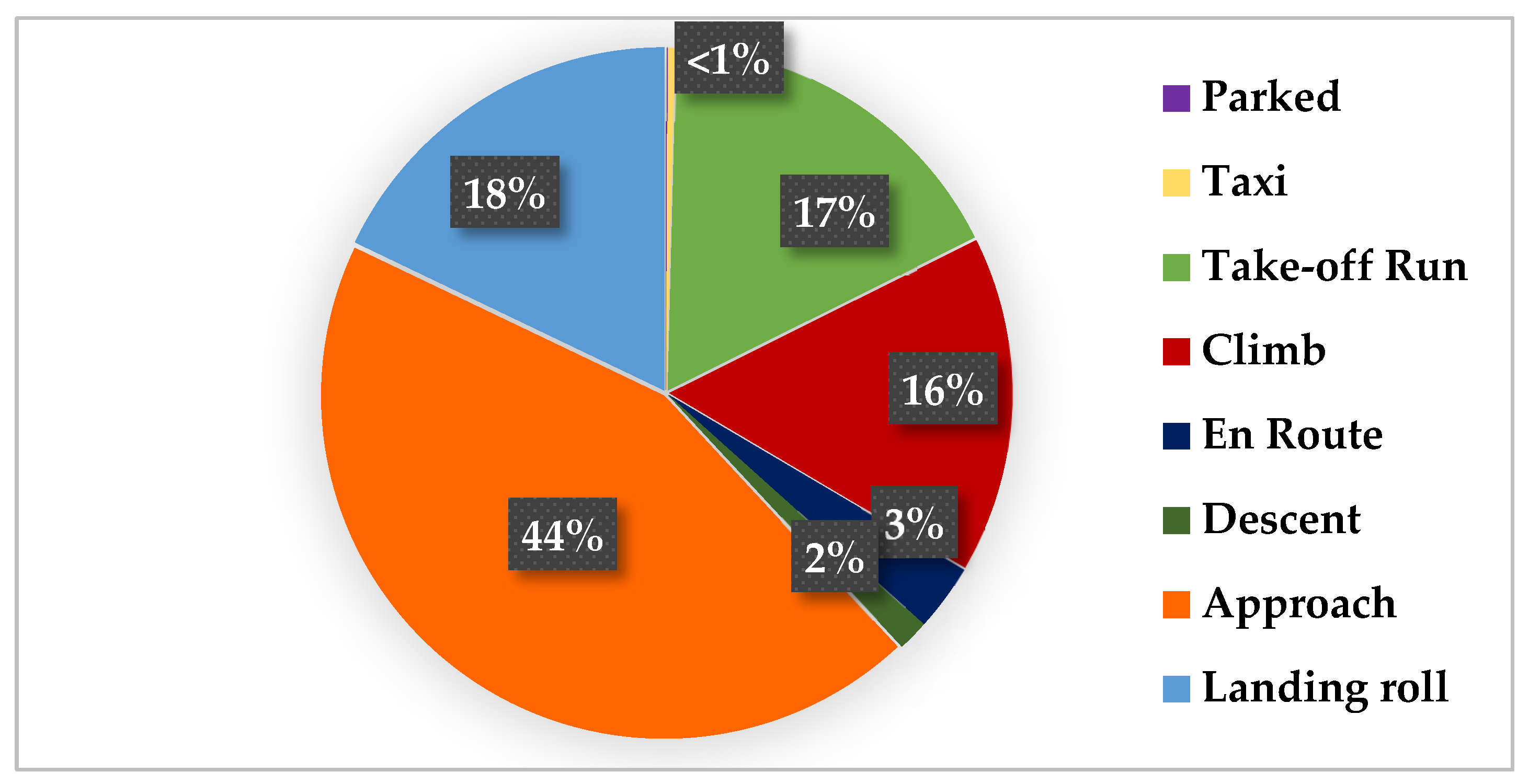
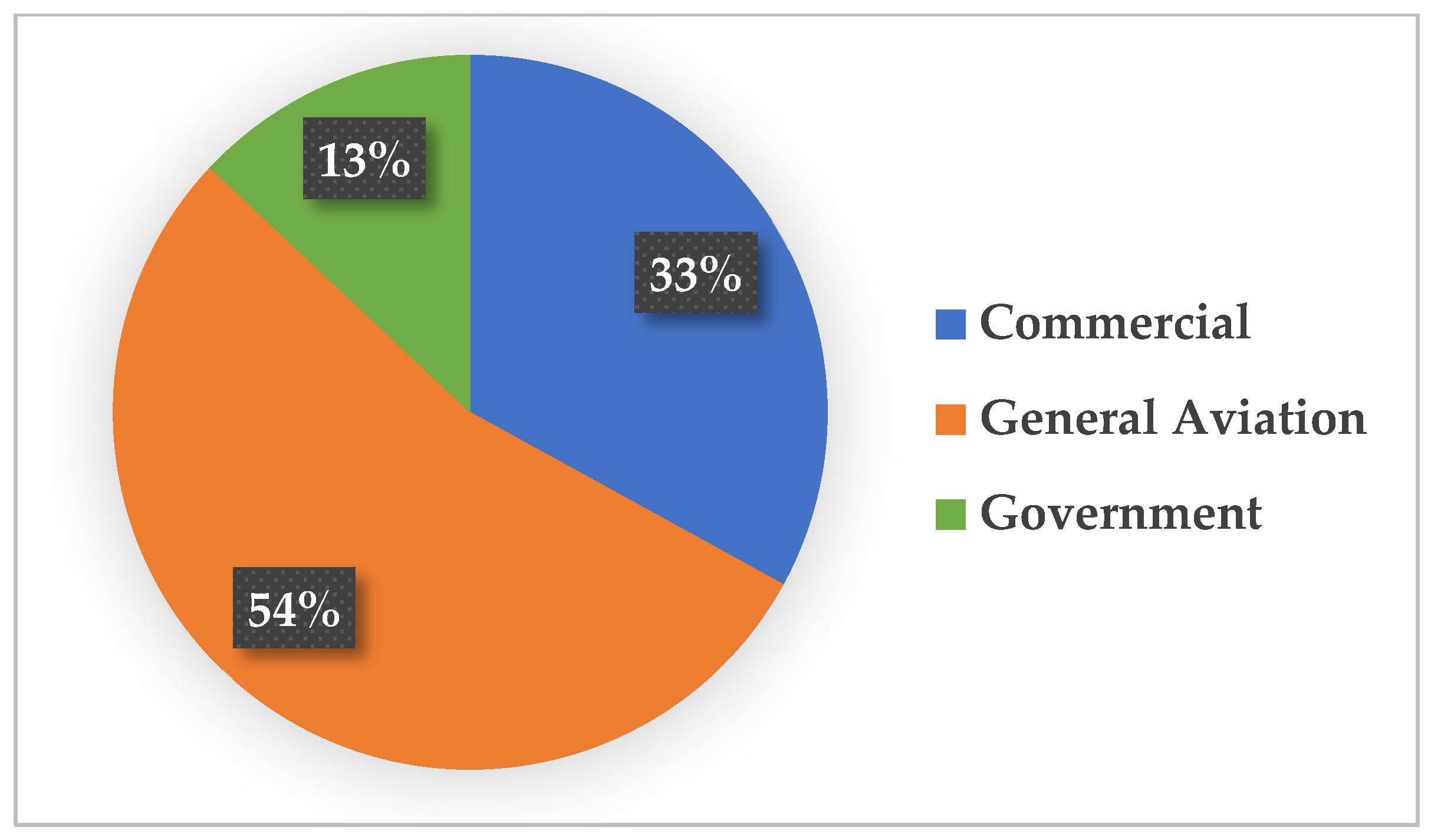
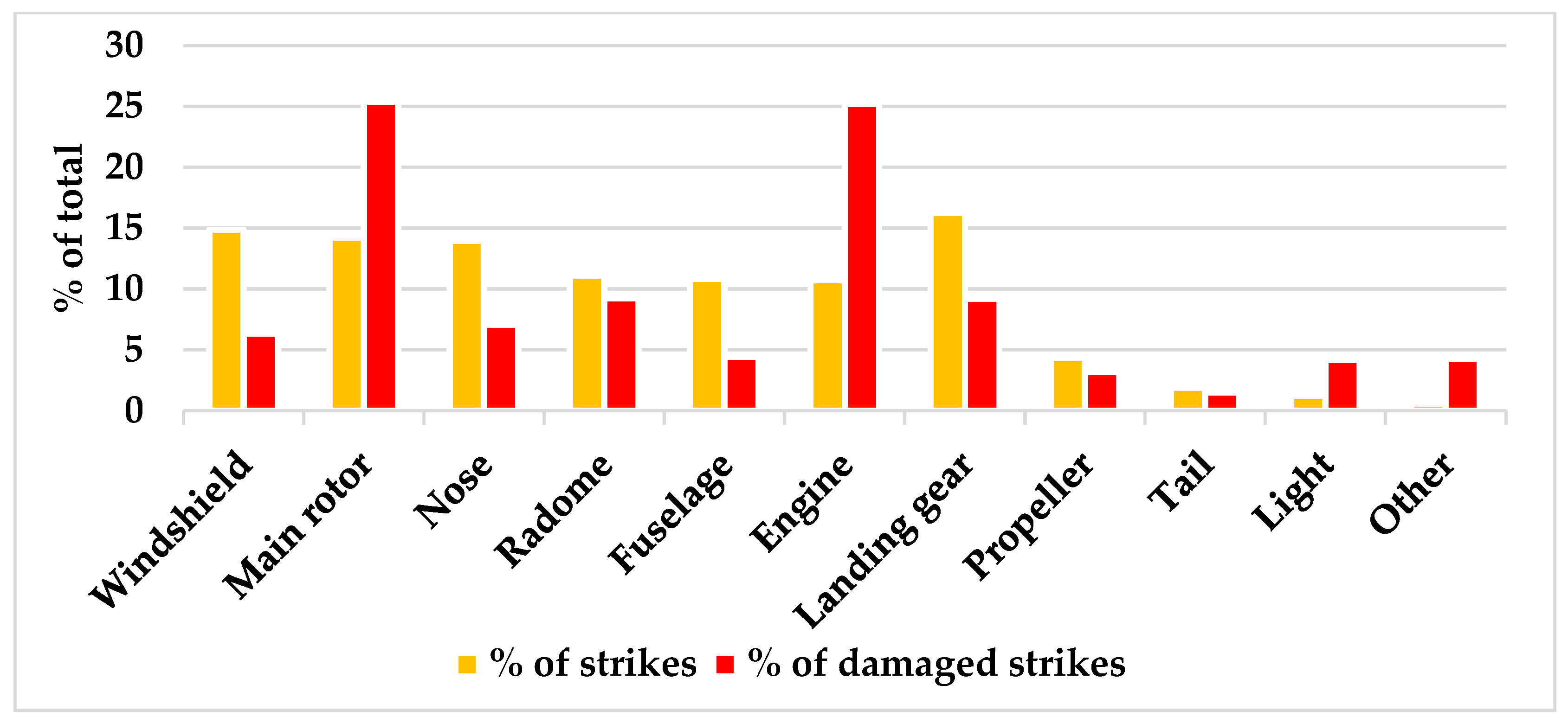
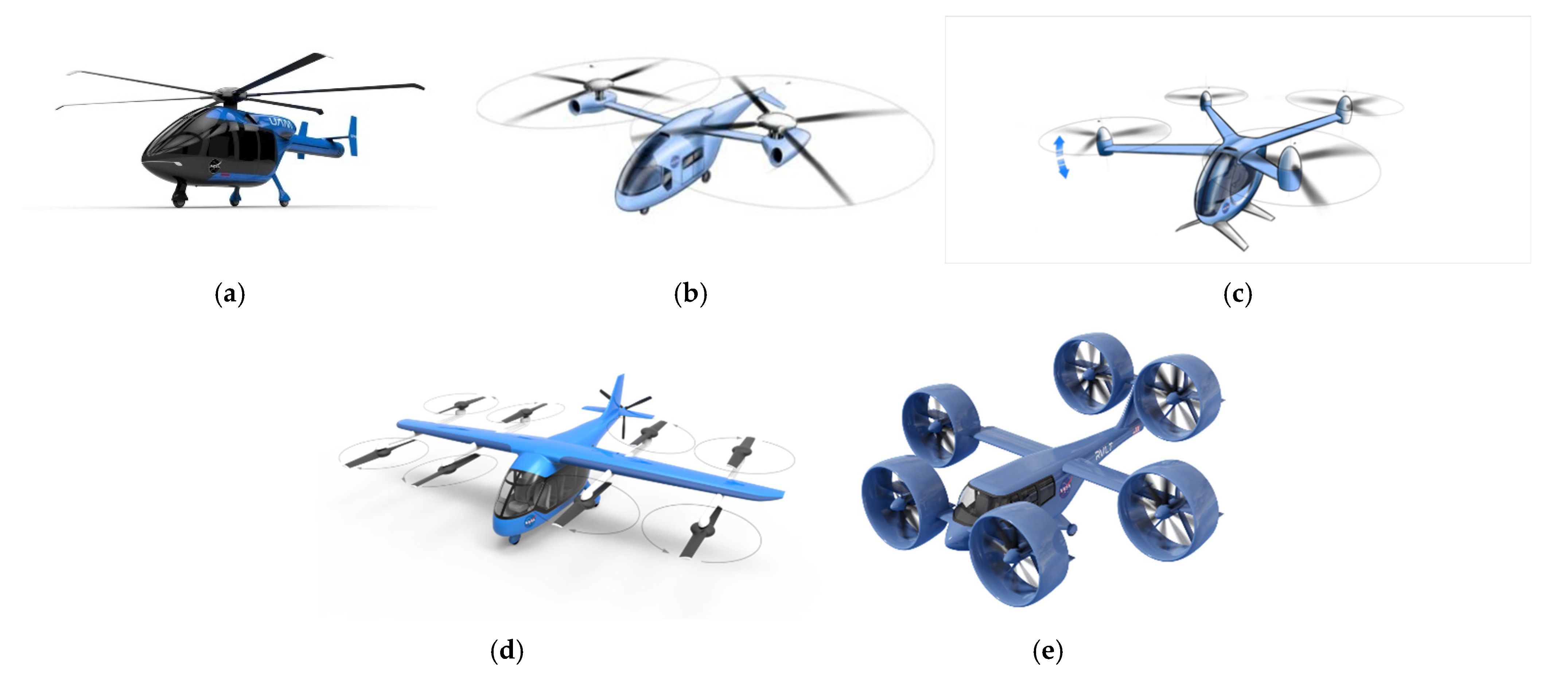

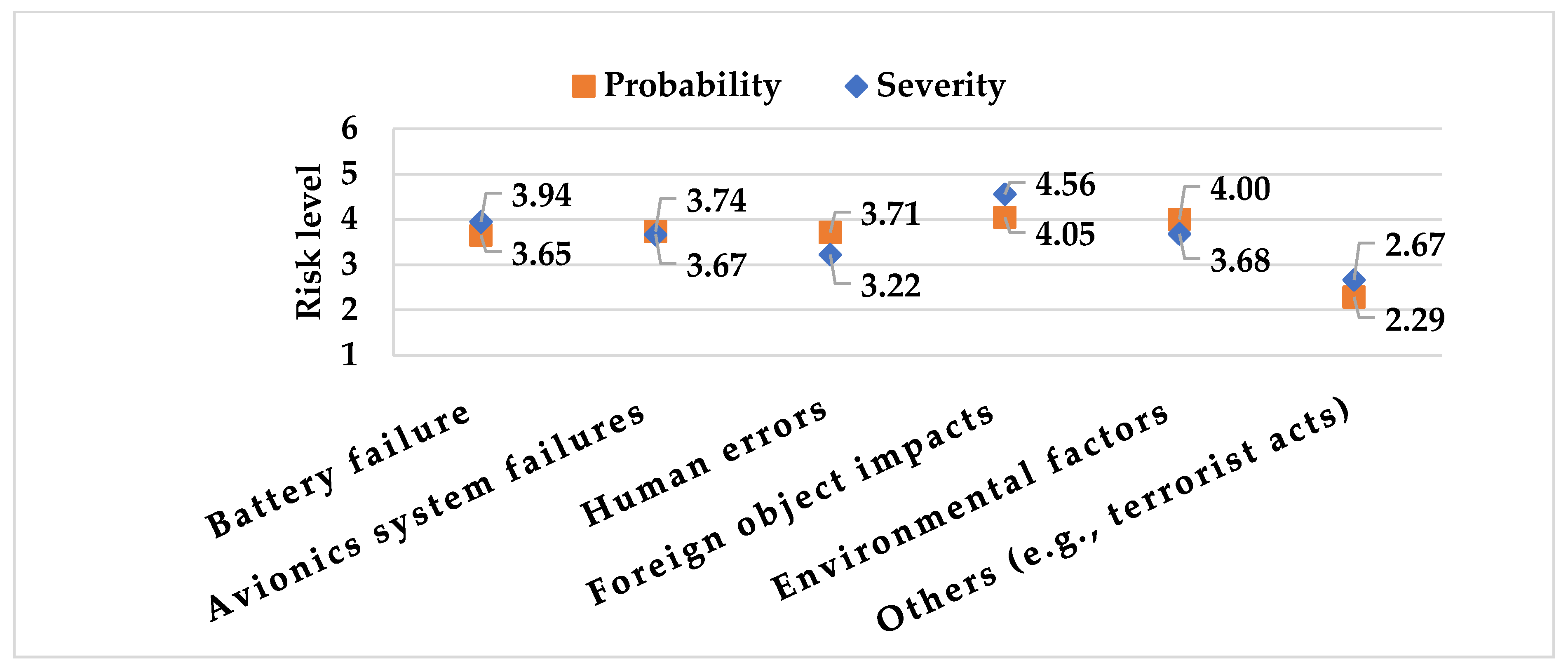
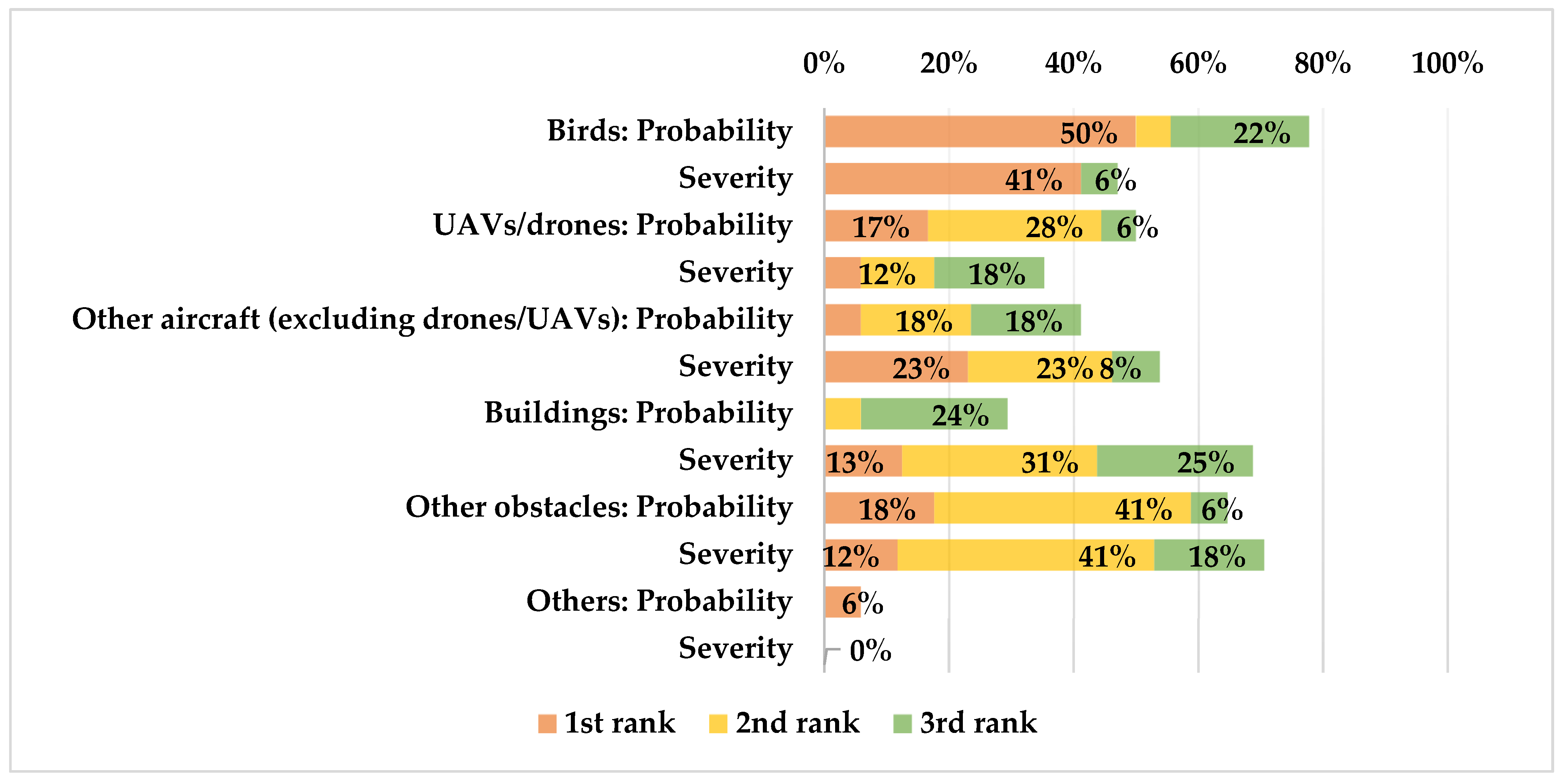
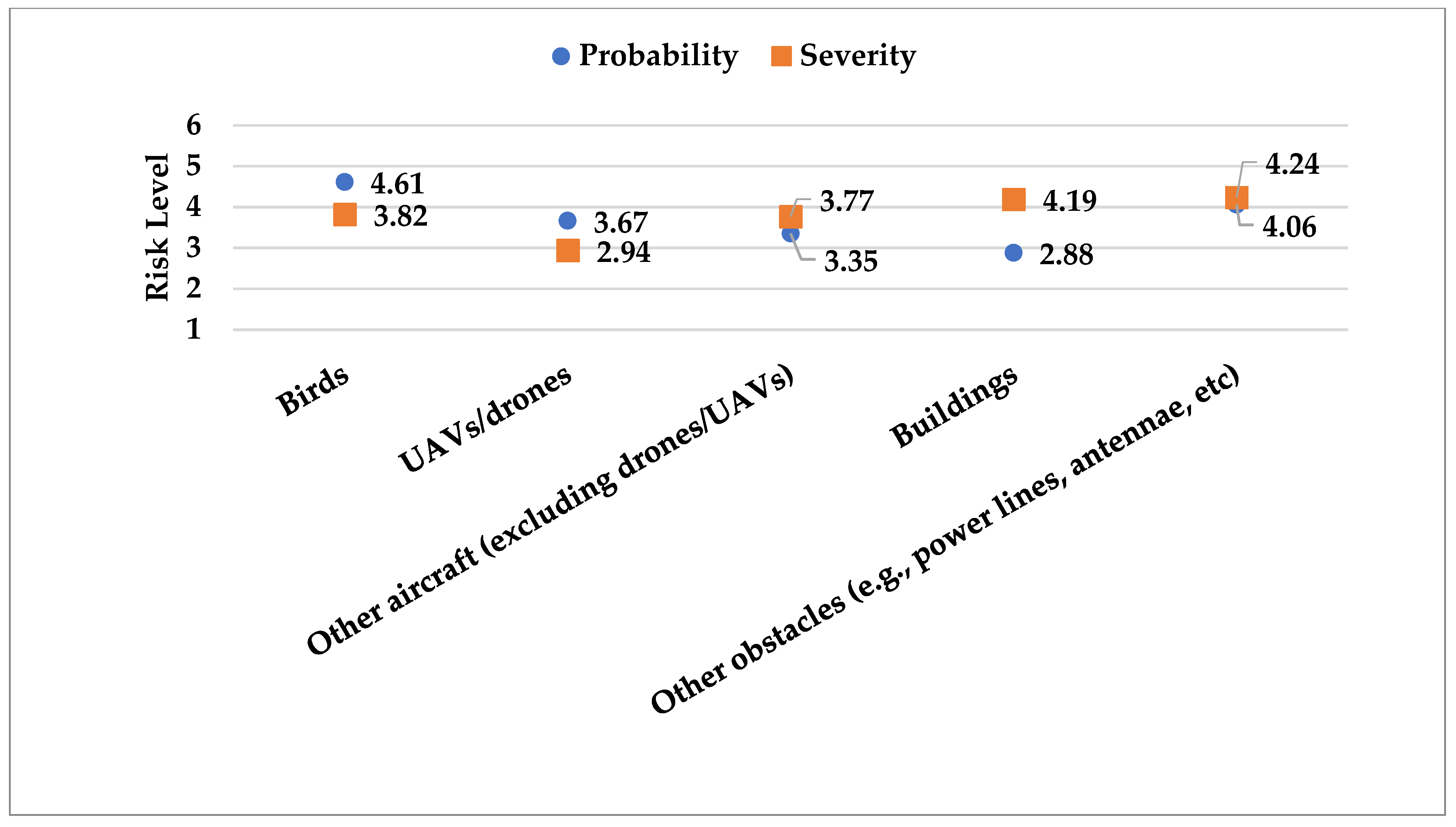
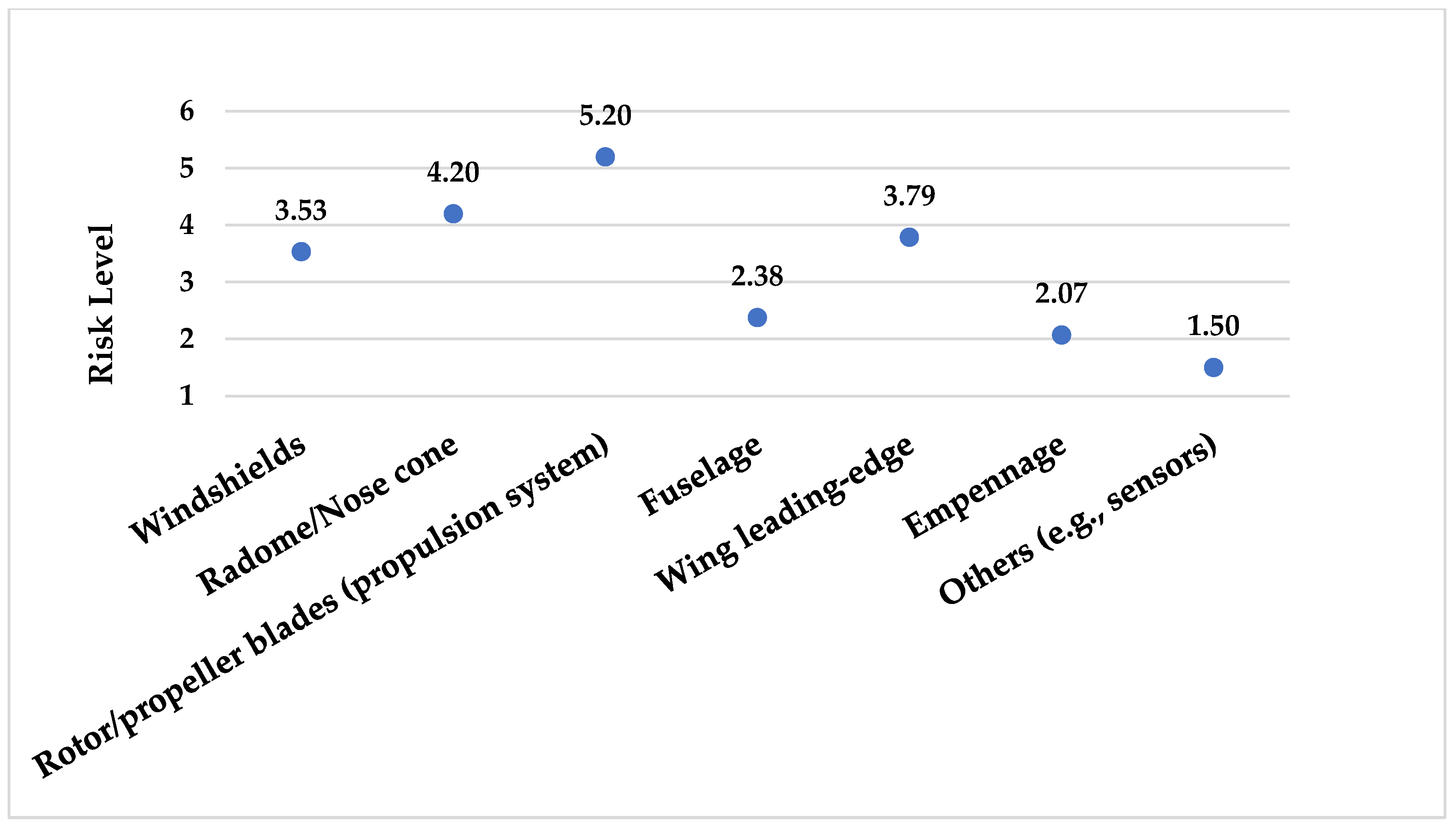



| Category | Number |
|---|---|
| Operational Risk Analysis | 4 |
| Safety Challenges | 6 |
| Conceptual Designs | 7 |
| Rotor Structure and Manufacturing | 7 |
| Terminology and Definition | 8 |
| Advanced Developments/Technologies | 10 |
| Standards and Regulatory | 10 |
| Others (e.g., Airspace Management, Infrastructure, Social Acceptance, Planning) | 10 |
| Impact Analysis | 11 |
| Applications of Key Stakeholders | 20 |
| Historical Events and Statistics | 24 |
| Experience Years in the Expertise Area | Count | Percentage |
|---|---|---|
| <1 years | 2 | 10% |
| 1–5 years | 7 | 35% |
| 6–10 years | 4 | 20% |
| 11–15 years | 1 | 5% |
| 16–20 years | 2 | 10% |
| 21–25 years | 0 | 0% |
| 26–30 years | 1 | 5% |
| >30 years | 3 | 15% |
| Ranking | Qualitative Likelihood | Definition |
|---|---|---|
| 1 | Extremely improbable | Almost inconceivable that this event will occur |
| 2 | Improbable | Very unlikely to occur |
| 3 | Remote | Unlikely to occur, but possible |
| 4 | Occasional | Likely to occur sometimes |
| 5 | Frequent | Likely to occur many times |
| 6 | Often | Likely to occur more than many times |
| Ranking | Qualitative Severity | Definition |
|---|---|---|
| 1 | Negligible | No relevant effect on safety |
| 2 | Very minor | Few consequences, no injuries |
| 3 | Minor | Low damage, nuisance, operating limitations, use of emergency procedures |
| 4 | Moderate | A significant reduction in operation ability, serious incident, injuries possible, |
| 5 | Hazardous | Causes a loss primary function, severe damage to major equipment, serious injuries to death |
| 6 | Catastrophic | Equipment destroyed, complete unsafe operation, multiple deaths |
| Probability Rank | 1st Rank | 2nd Rank | 3rd Rank | 4th Rank | 5th Rank | 6th Rank | Total Responses | Average Score |
|---|---|---|---|---|---|---|---|---|
| Probability Scale | 6 | 5 | 4 | 3 | 2 | 1 | ||
| Battery failure | 4 | 1 | 3 | 7 | 5 | 0 | 20 | 3.6 |
| Key Hazards | Rank | ||||||
|---|---|---|---|---|---|---|---|
| 1st | 2nd | 3rd | 4th | 5th | 6th | ||
| Probability | Battery failure (electric system and/or propulsion system) | 20% | 10% | 10% | 35% | 25% | 0% |
| Avionics, navigation and/or flight control systems failure (e.g., high-level autonomous system, Fly-By-Wire, autopilot, detect and avoid system, etc.) | 16% | 11% | 32% | 16% | 26% | 0% | |
| Human errors | 24% | 29% | 10% | 0% | 10% | 29% | |
| Foreign object impacts (e.g., bird strike, drones, obstacles and/or collision with another air vehicle) | 19% | 19% | 24% | 29% | 5% | 5% | |
| Environmental factors (e.g., wind, turbulence, terrain, and weather) | 16% | 32% | 11% | 21% | 21% | 0% | |
| Others (disruptive technologies (jammers GPS signals, etc.)) | 14% | 14% | 0% | 0% | 0% | 71% | |
| Severity | Battery failure (electric system and/or propulsion system) | 28% | 17% | 6% | 33% | 6% | 11% |
| Avionics, navigation and/or flight control systems failure (e.g., high-level autonomous system, Fly-By-Wire, autopilot, detect and avoid system, etc.) | 17% | 22% | 17% | 0% | 44% | 0% | |
| Human errors | 17% | 17% | 6% | 22% | 11% | 28% | |
| Foreign object impacts (e.g., bird strike, drones, obstacles and/or collision with another air vehicle) | 33% | 17% | 28% | 17% | 6% | 0% | |
| Environmental factors (e.g., wind, turbulence, terrain, and weather) | 5% | 21% | 32% | 21% | 21% | 0% | |
| Others (shot-down, terrorist acts, endurance issues) | 0% | 33% | 0% | 0% | 33% | 33% | |
| Key Foreign Objects | Rank | ||||||
|---|---|---|---|---|---|---|---|
| 1st | 2nd | 3rd | 4th | 5th | 6th | ||
| Probability | Birds | 50% | 6% | 22% | 6% | 11% | 6% |
| UAVs/drones | 17% | 28% | 6% | 22% | 11% | 17% | |
| Other aircraft (excluding drones/UAVs) | 6% | 18% | 18% | 29% | 24% | 6% | |
| Buildings | 0% | 6% | 24% | 35% | 24% | 12% | |
| Other obstacles (e.g., power lines, antennae, etc.) | 18% | 41% | 6% | 6% | 24% | 6% | |
| Others | 6% | 0% | 0% | 0% | 0% | 0% | |
| Severity | Birds | 41% | 0% | 6% | 12% | 35% | 6% |
| UAVs/drones | 6% | 12% | 18% | 24% | 18% | 24% | |
| Other aircraft (excluding drones/UAVs) | 23% | 23% | 8% | 8% | 31% | 8% | |
| Buildings | 13% | 31% | 25% | 25% | 6% | 0% | |
| Other obstacles (e.g., power lines, antennae, etc.) | 12% | 41% | 18% | 18% | 12% | 0% | |
| Others | 0% | 0% | 0% | 0% | 0% | 0% | |
| Main Aircraft Parts | Rank | ||||||
|---|---|---|---|---|---|---|---|
| 1st | 2nd | 3rd | 4th | 5th | 6th | ||
| Probability and Severity | Windshields | 7% | 33% | 7% | 27% | 13% | 13% |
| Radome/Nose cone | 33% | 13% | 20% | 13% | 13% | 7% | |
| Rotor/propeller blades (propulsion system) | 53% | 20% | 20% | 7% | 0% | 0% | |
| Fuselage | 13% | 0% | 13% | 0% | 38% | 38% | |
| Wing leading-edge | 0% | 29% | 21% | 50% | 0% | 0% | |
| Empennage | 0% | 7% | 21% | 0% | 14% | 57% | |
| Key Foreign Objects | Rank | ||||||
|---|---|---|---|---|---|---|---|
| 1st | 2nd | 3rd | 4th | 5th | 6th | ||
| Severity | Single main rotor (wingless) | 53% | 20% | 13% | 0% | 7% | 7% |
| Multirotor (wingless) | 21% | 29% | 0% | 21% | 14% | 14% | |
| Lift-and-cruise (fixed wing) | 7% | 7% | 20% | 20% | 40% | 7% | |
| Tilting system | 14% | 21% | 36% | 21% | 7% | 0% | |
| Ducted rotor | 0% | 14% | 29% | 21% | 21% | 14% | |
| Others | 0% | 0% | 0% | 0% | 0% | 0% | |
| Safety Risk Zone | Meaning | Recommended Procedure |
|---|---|---|
| Intolerable | Take immediate action to mitigate the safety risk index to the tolerable | |
| Tolerable | A management decision may require approaching an acceptable risk range | |
| Acceptable | No further safety risk mitigation necessarily required |
| Key Hazards | Probability | Severity | Risk |
|---|---|---|---|
| Battery failure (electric system and/or propulsion system) | 3.65 | 3.94 | 14.40  |
| Avionics, navigation and/or flight control systems failure (e.g., high-level autonomous system, Fly-By-Wire, autopilot, detect and avoid system, etc.) | 3.74 | 3.67 | 13.70  |
| Human errors | 3.71 | 3.22 | 11.97  |
| Foreign object impacts (e.g., bird strike, drones, obstacles and/or collision with another air vehicle) | 4.05 | 4.56 | 18.44  |
| Environmental factors (e.g., wind, turbulence, terrain, and weather) | 4.00 | 3.68 | 14.74  |
| Others (shot down like MH17, terrorist acts) | 2.29 | 2.67 | 6.10  |
| Key Hazards | Probability | Severity | Risk |
|---|---|---|---|
| Birds | 4.61 | 3.82 | 17.63 |
| UAVs/drones | 3.67 | 2.94 | 10.78 |
| Other aircraft (excluding drones/UAVs) | 3.35 | 3.77 | 12.64 |
| Buildings | 2.88 | 4.19 | 12.07 |
| Other obstacles (e.g., power lines, antennae, etc.) | 4.06 | 4.24 | 17.19 |
| Others | 0.00 | 0.00 | 0.00 |
| Aircraft Component | Probability | Severity | Risk |
|---|---|---|---|
| Windshield | 3.53 | 3.53 | 12.48 |
| Radome/Nose cone | 4.20 | 4.20 | 17.64 |
| Rotor/propeller blades (propulsion system) | 5.20 | 5.20 | 27.04 |
| Fuselage | 2.31 | 2.31 | 5.35 |
| Wing leading-edge | 3.79 | 3.79 | 14.33 |
| Empennage | 1.71 | 1.71 | 2.94 |
Disclaimer/Publisher’s Note: The statements, opinions and data contained in all publications are solely those of the individual author(s) and contributor(s) and not of MDPI and/or the editor(s). MDPI and/or the editor(s) disclaim responsibility for any injury to people or property resulting from any ideas, methods, instructions or products referred to in the content. |
© 2025 by the authors. Licensee MDPI, Basel, Switzerland. This article is an open access article distributed under the terms and conditions of the Creative Commons Attribution (CC BY) license (https://creativecommons.org/licenses/by/4.0/).
Share and Cite
Charnsethikul, C.; Silva, J.M.; Verhagen, W.J.C.; Das, R. Urban Air Mobility Aircraft Operations in Urban Environments: A Review of Potential Safety Risks. Aerospace 2025, 12, 306. https://doi.org/10.3390/aerospace12040306
Charnsethikul C, Silva JM, Verhagen WJC, Das R. Urban Air Mobility Aircraft Operations in Urban Environments: A Review of Potential Safety Risks. Aerospace. 2025; 12(4):306. https://doi.org/10.3390/aerospace12040306
Chicago/Turabian StyleCharnsethikul, Chananya, Jose M. Silva, Wim J. C. Verhagen, and Raj Das. 2025. "Urban Air Mobility Aircraft Operations in Urban Environments: A Review of Potential Safety Risks" Aerospace 12, no. 4: 306. https://doi.org/10.3390/aerospace12040306
APA StyleCharnsethikul, C., Silva, J. M., Verhagen, W. J. C., & Das, R. (2025). Urban Air Mobility Aircraft Operations in Urban Environments: A Review of Potential Safety Risks. Aerospace, 12(4), 306. https://doi.org/10.3390/aerospace12040306










